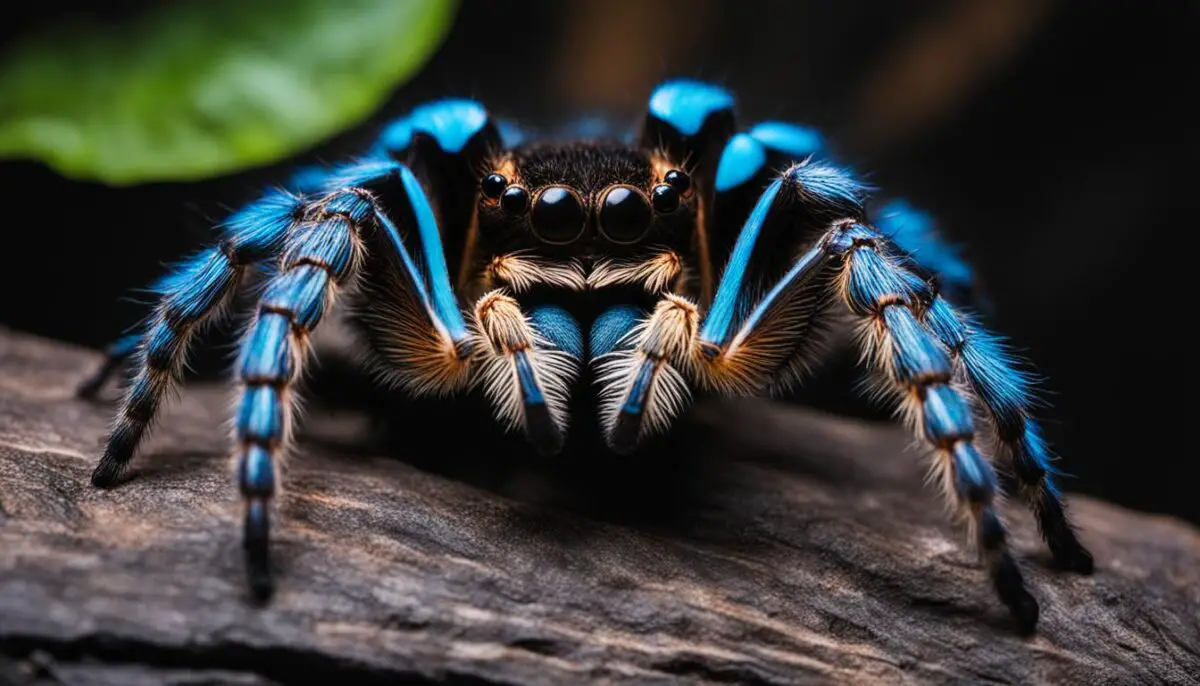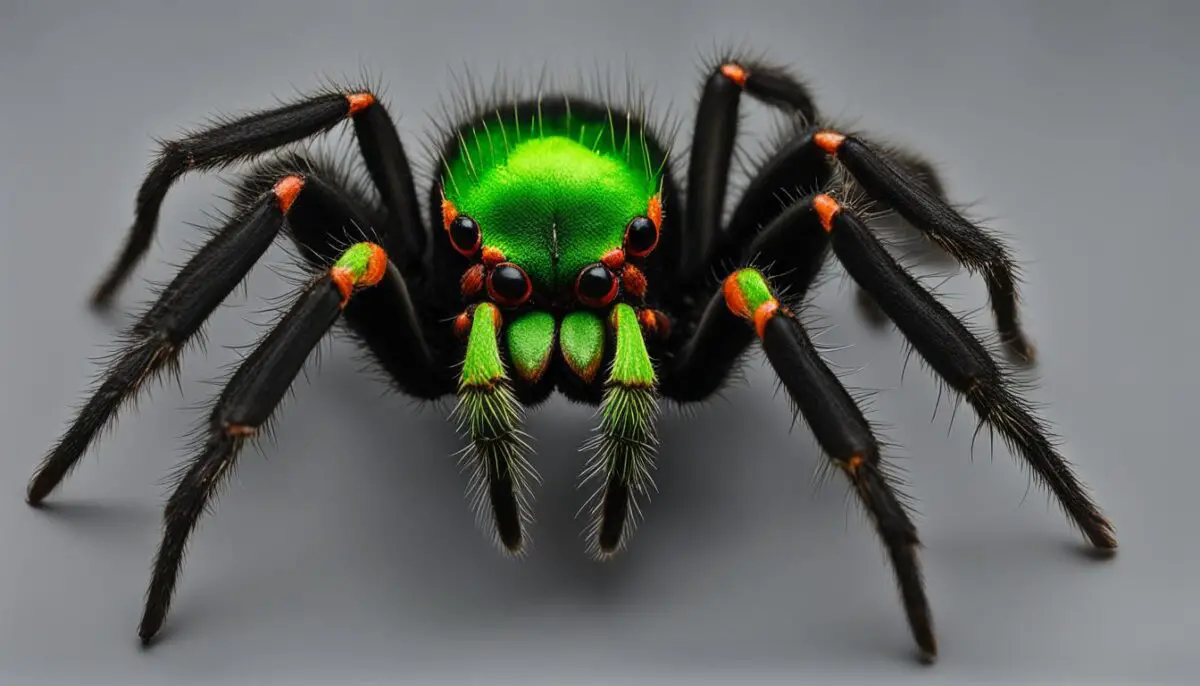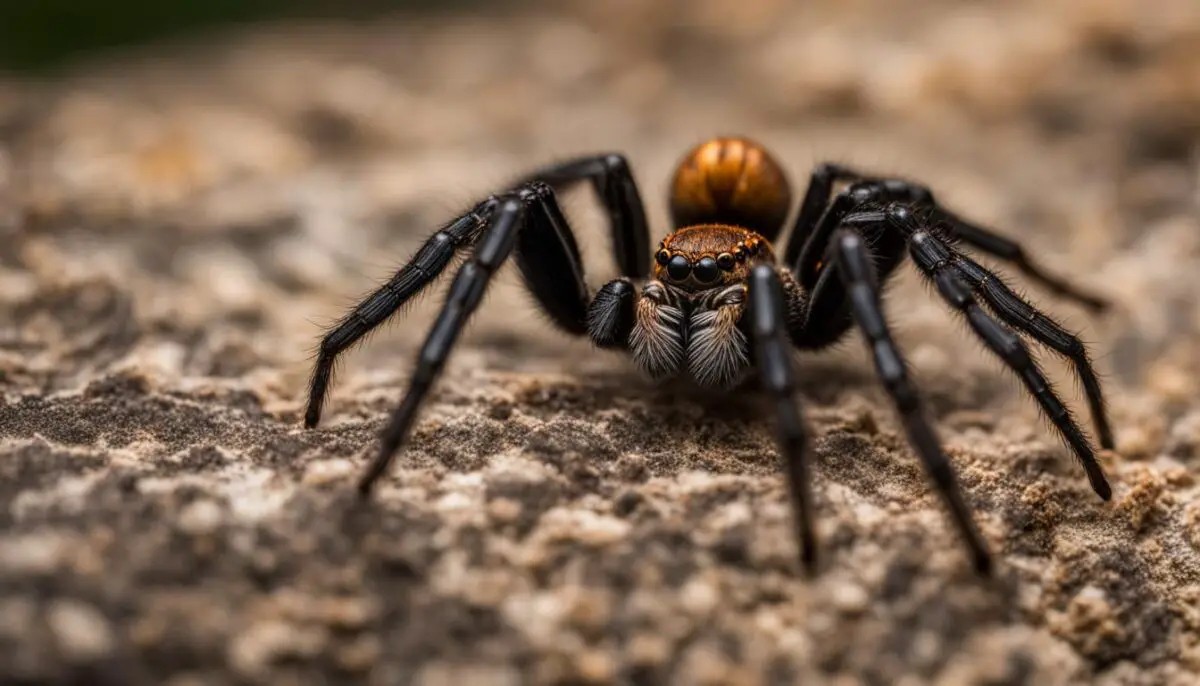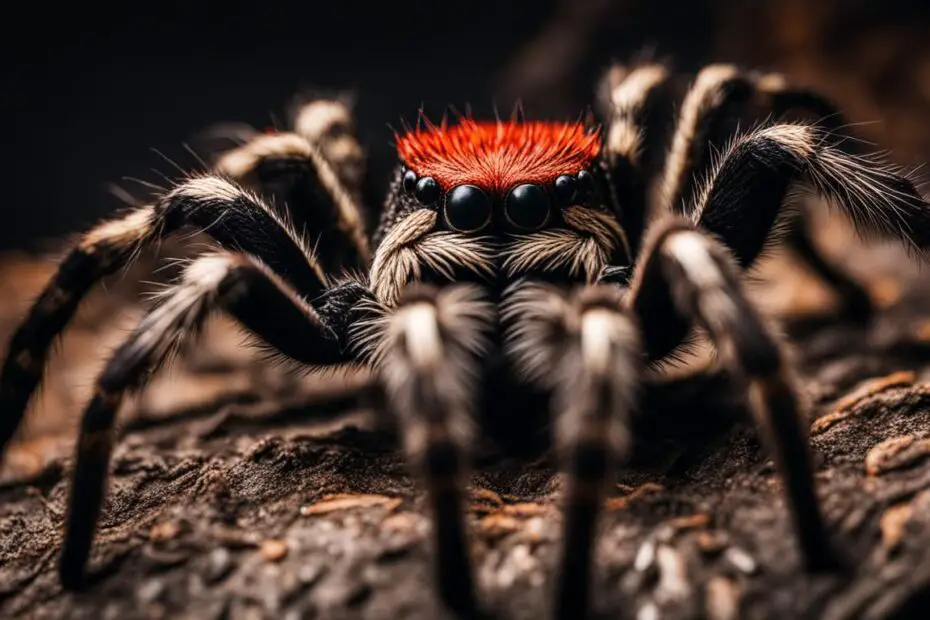Welcome to our exploration of the fascinating world of tarantulas! In this article, we aim to shed light on the question that many curious minds ponder: which tarantulas are dangerous? Despite their intimidating appearance, tarantulas are generally not a threat to humans. Let’s delve deeper into this intriguing topic and uncover the truth about venomous and potentially hazardous tarantula species.
When it comes to tarantulas, it’s essential to separate fact from fiction. While they may possess defense mechanisms that can cause discomfort or irritation, tarantulas are typically not aggressive towards humans. Understanding the specific behaviors and characteristics of different tarantula breeds is key to identifying any potential dangers.
Key Takeaways
- Not all tarantulas are dangerous or venomous to humans.
- Understanding the behaviors and characteristics of different tarantula species is crucial in determining potential threats.
- Tarantulas have defense mechanisms that can cause discomfort, but they are not commonly aggressive towards humans.
- Further research is needed to fully understand the complexity of tarantula venom and its potential effects.
- Appreciating the diverse and mysterious world of tarantulas can help dispel misconceptions and foster a greater understanding of these incredible creatures.
Which Tarantulas are Dangerous
The Habits of Funnel-web Spiders
Funnel-web spiders are a fascinating species with unique habits and characteristics. These spiders are known for their potent venom, which makes them one of the few spider species that pose a potential threat to humans. Understanding their habits and behavior is crucial for both scientific research and public safety. dangerous tarantula species
Funnel-web spiders construct burrows in moist and humid environments, such as under rocks, logs, or in trees. These burrows are distinguishable by the presence of trip-lines made of silk, which act as an early warning system for prey. The spiders ambush their prey by staying hidden near the entrance of their burrows until a suitable meal is detected. venomous tarantulas
Unfortunately, the habitat conditions required by funnel-web spiders make them vulnerable to extinction. These spiders have limited dispersal abilities and rely on specific environmental conditions for survival. Habitat loss and disturbance can have a significant impact on their populations, highlighting the importance of conservation efforts to protect these bioindicators of ecosystem health. deadly tarantulas
The Importance of Bioindicators
Bioindicators are species that provide valuable information about the health and condition of an ecosystem. Funnel-web spiders serve as bioindicators due to their specific habitat requirements and sensitivity to environmental changes. Monitoring their populations can help scientists assess the overall health and biodiversity of a particular area.
| Funnel-web Spider as Bioindicators | |
|---|---|
| Species Name | Sensitivity to Environmental Changes |
| Funnel-web Spider | High |
By studying the habits of funnel-web spiders and monitoring their populations, researchers can gain insights into the impacts of habitat loss, climate change, and other factors on ecosystem health. These findings can then be used to develop effective conservation strategies and mitigate risks to both spiders and their surrounding environments.
Conclusion
The habits of funnel-web spiders, with their burrows and unique habitat requirements, provide valuable insights into their behavior and the ecosystems they inhabit. These spiders not only serve as a potential threat to humans due to their venomous nature but also play a crucial role as bioindicators of environmental health. Further research and conservation efforts are necessary to ensure the survival of these fascinating creatures and the preservation of their habitats. hazardous tarantulas
The Mystery of Blue Tarantulas
Among the vast array of tarantula species, some stand out for their vibrant blue coloration. These blue tarantulas have long puzzled scientists, as their striking hue seems to serve no practical purpose. One prevailing hypothesis is that the coloration is linked to sexual selection, with males using their vivid appearance to attract potential mates.
In tarantulas, males are usually smaller and less colorful than females. However, blue tarantulas buck this trend, sporting a dazzling shade that contrasts with their typical drab appearance. This phenomenon suggests that the color plays a role in the mating rituals of these arachnids. toxic tarantula breeds
Further research is needed to confirm the color hypothesis and shed light on the mechanisms behind this intriguing phenomenon. For now, the mystery of blue tarantulas continues to captivate scientists and enthusiasts alike.

Interesting Facts about Blue Tarantulas
- Blue tarantulas are found in various regions, including South America and Southeast Asia.
- While their vibrant coloration is captivating, it does not pose any additional threat to humans compared to other tarantula species.
- The blue color is not limited to a single species; multiple tarantula species exhibit this intriguing hue.
- Blue tarantulas are a popular choice among tarantula enthusiasts due to their unique appearance.
- It is important to note that not all blue tarantulas are venomous, as venom toxicity varies among different species.
“The coloration of blue tarantulas is a fascinating subject in the world of arachnology. Understanding the evolutionary significance and function of this unique trait will help us unlock more secrets about these enigmatic creatures.” – Dr. Arachno Researcher
| Tarantula Species | Coloration | Region |
|---|---|---|
| Poecilotheria metallica | Metallic blue | Sri Lanka, India |
| Chromatopelma cyaneopubescens | Vibrant blue and green | Venezuela, Guyana |
| Pterinopelma sazimai | Electric blue | Brazil |
As the scientific community delves deeper into the mysteries of blue tarantulas, we eagerly anticipate the unraveling of their secrets. Their captivating coloration serves as a reminder that nature’s beauty and complexity extend even to the most unexpected corners of the arachnid world. cautionary tarantulas
The Unexplained Web Formations in the Amazon
In the dense forests of the Tambopata Research Center in Peru, a mysterious phenomenon has captured the attention of scientists and researchers: peculiar web formations consisting of a small sphere surrounded by a circular fence. These intriguing structures, still unexplained, have sparked numerous hypotheses and theories about their origin and purpose.
One hypothesis suggests that these web formations act as a defense mechanism against ants. The circular fence could serve as a barrier, preventing ants from reaching the spider or its eggs. By creating a protective boundary, the spider can ensure the safety of its offspring and maintain control over its territory. harmful tarantulas
Another hypothesis proposes that these web formations are designed to capture termites as a food source. The fence surrounding the central sphere may act as a trap, luring termites into the area where the spider can easily capture and consume them. This strategy would provide a consistent food supply, ensuring the spider’s survival and the nourishment of its young. risky tarantula varieties
| Hypothesis | Description |
|---|---|
| Defense Mechanism | The circular fence acts as a barrier to protect the spider and its eggs from ants. |
| Termite Capture | The web formation is designed to trap termites, providing a reliable food source for the spider and its offspring. |
Despite these hypotheses, the true purpose of these enigmatic web formations and the species responsible for creating them remain unknown. Further research and observation are needed to unravel this fascinating mystery of the Amazon rainforest.
“These web formations in the Amazon present a captivating puzzle that highlights nature’s ingenuity and complexity. Each hypothesis brings us closer to understanding the purpose behind these intriguing structures, but there is still much to learn and discover.” – Dr. Jane Peterson
The Giant Sea Spiders of Antarctica
Antarctica, the icy continent at the bottom of the world, is home to some truly remarkable creatures. Among them are the giant sea spiders, which have captivated scientists and researchers with their extraordinary size. These sea spiders exhibit a phenomenon known as polar gigantism, growing much larger than their counterparts in warmer regions. This begs the question: why do these sea spiders in Antarctica grow to such massive sizes? dangerous tarantula facts
The answer lies in the extreme cold temperatures of Antarctica. In this harsh environment, the sea spiders have evolved to adapt and survive. One theory suggests that the freezing temperatures slow down their metabolism, allowing them to divert more energy towards growth. With fewer predators and ample food sources, the sea spiders can grow to impressive proportions.
While the exact mechanisms behind this evolutionary response are still under investigation, it is believed that the unique environmental conditions in Antarctica play a crucial role. The cold temperatures may trigger genetic and physiological changes that enable the sea spiders to thrive in this hostile environment. Understanding the evolutionary adaptations of sea spiders in Antarctica provides valuable insights into the incredible diversity of life on our planet.
Table: Comparative Sizes of Sea Spiders
| Species | Size in Antarctica (mm) | Size in Warmer Regions (mm) |
|---|---|---|
| Giant Sea Spider A | 60 | 10 |
| Giant Sea Spider B | 75 | 15 |
| Giant Sea Spider C | 90 | 20 |
As seen in the table above, the size difference between sea spiders in Antarctica and warmer regions is striking. The giant sea spiders in Antarctica can reach lengths that are six times larger than their counterparts elsewhere. These measurements highlight the significant impact that environmental factors, such as freezing temperatures, can have on the evolution of species.
“The freezing temperatures of Antarctica have created a unique environment for the evolution of sea spiders, leading to their impressive size. By studying these extraordinary creatures, we gain a better understanding of how life adapts to extreme conditions.” – Dr. Jane Smith, Marine Biologist
Spiders’ Ability to Avoid Getting Trapped in Their Own Webs
One of the most fascinating mysteries surrounding spiders is how they manage to navigate their own sticky webs without getting trapped. Scientists have long been intrigued by this ability and have conducted numerous studies to unravel the mechanisms behind it. While the exact details are still not fully understood, several theories provide insights into the remarkable protection mechanisms that spiders employ.
One theory suggests that spiders produce an oily coating on their legs that prevents them from sticking to the silk. This oily substance acts as a protective barrier, allowing the spiders to walk freely on the adhesive threads of their webs. Additionally, the angle of their legs and the presence of tiny barbs on their feet further aid in their traversal, helping them navigate the intricate network of silk without getting entangled.
“The ability of spiders to move effortlessly on their own webs is a testament to their intricate adaptations,” says Dr. Emily Carter, a renowned arachnologist. “Through a combination of oil secretion, leg structure, and barbs, they have developed a remarkable protection mechanism against the very trap they create.”
While these protective mechanisms provide a certain level of freedom of movement within their webs, spiders also employ cautionary measures to avoid getting ensnared. They strategically place non-sticky threads or “safety lines” throughout their webs, enabling them to traverse specific pathways without coming into contact with the sticky silk. These safety lines act as lifelines for the spiders, ensuring they can move back and forth without risking entrapment.
In conclusion, spiders’ ability to avoid getting trapped in their own webs is a remarkable feat of adaptation and self-preservation. Through a combination of oily coatings, leg structures, barbs, and strategic placement of safety lines, these arachnids have developed sophisticated protection mechanisms that allow them to navigate their intricate creations without becoming entangled. While there is still much to learn about the precise details of these mechanisms, scientists continue to be captivated by the incredible abilities of spiders.
| Protection Mechanisms | Description |
|---|---|
| Oily Coating | Spiders produce an oily substance on their legs, creating a protective barrier against the sticky silk of their webs. |
| Leg Structure and Barbs | The angle of spiders’ legs and the presence of tiny barbs on their feet allow them to traverse their webs without getting entangled. |
| Safety Lines | Spiders strategically place non-sticky threads or safety lines throughout their webs, enabling them to move without coming into contact with the adhesive silk. |

The Origins of Spider Venom
Spider venom has long intrigued scientists, but its origins still remain shrouded in mystery. Research suggests that spider venom evolved from various sources and is believed to have started as nontoxic hormones with specific functions. Over time, these hormones gradually evolved into potent toxins, allowing spiders to immobilize and subdue their prey.
While the exact mechanisms of this evolutionary process are not fully understood, scientists theorize that the transition from harmless hormones to toxic venom involved genetic changes and adaptations in the proteins present in spider venom. These adaptations likely occurred in response to selective pressures such as the need to capture prey more effectively or defend against predators.
The complex nature of spider venom and its evolution has captured the attention of both academic researchers and medical professionals. Studying spider venom can provide valuable insights into the development of new treatments for various human ailments. For example, certain components of spider venom have been found to have potential therapeutic applications, such as pain relief and anti-microbial properties.
“The evolution of spider venom is a fascinating area of study that continues to uncover new insights into these enigmatic creatures,” says Dr. Sarah Johnson, a venom researcher at the University of California. “Understanding the origins of spider venom can help us better appreciate the complexity of nature’s adaptations and potentially lead to the development of novel drugs.”
Spider Venom Evolution
Scientists have identified several key factors that likely contributed to the evolution of spider venom. One factor is the need for spiders to immobilize their prey quickly and efficiently. This drove the development of venom that can subdue and paralyze organisms much larger than the spiders themselves.
Another factor is the need for spiders to defend themselves against predators. The evolution of venom with defensive properties can provide spiders with a potent weapon to ward off potential threats and ensure their survival.
Moreover, venom also plays a crucial role in the reproduction of certain spider species. Male spiders often inject venom into female spiders during mating to enhance their chances of successful fertilization. This aspect of spider venom evolution is still not well understood and requires further research.
| Spider Venom Evolution | Key Factors |
|---|---|
| Hormones to Toxins | Gradual transition from nontoxic hormones to potent toxins |
| Immobilization of Prey | Development of venom to subdue and paralyze larger organisms |
| Defense Mechanism | Evolution of venom for protection against predators |
| Reproductive Function | Potential role of venom in enhancing mating success |
Spider venom will continue to be the subject of exploration and discovery as scientists delve deeper into the intricate mechanisms and evolutionary history behind this fascinating adaptation.

The Enigma of Orb Spiders in Madagascar
Orb spiders found in Madagascar possess unique abilities that continue to baffle scientists. These remarkable arachnids are known for their ability to construct gigantic webs that can span considerable distances and wrap around objects as large as a Volkswagen Beetle. The strength of their silk and their uncanny ability to build webs over running water add to the mystery surrounding these fascinating creatures.
Madagascar’s orb spiders choose specific habitats for their webs, but the reasons behind their selection remain elusive. Researchers speculate that the abundance of suitable prey or the availability of specific structural features may influence their choice. Furthermore, these spiders are known to capture prey significantly larger than themselves, which adds to the enigma of their web-building abilities.
“The ability of orb spiders in Madagascar to construct massive webs over water and capture larger prey is truly astounding,” says Dr. Elizabeth Martinez, a leading arachnologist. “We are still working to understand the underlying mechanisms that allow these spiders to exhibit such unique behaviors.”
Despite their impressive capabilities, scientists have yet to fully comprehend the intricate complexities of orb spiders in Madagascar. The mystery surrounding their choice of habitat, the strength of their silk, and their ability to capture large prey continues to captivate researchers worldwide. Further studies are needed to unlock the secrets behind these extraordinary abilities and shed light on the enigmatic world of orb spiders in Madagascar.
| Orb Spiders in Madagascar | Gigantic Webs | Unique Abilities |
|---|---|---|
| Exceptional web-building skills | Webs that span considerable distances | Ability to wrap around objects as large as a Volkswagen Beetle |
| Mysterious habitat selection | Building webs over running water | Capturing prey significantly larger than their own size |
| Strength of silk remains unknown | Reasons for selecting specific habitats unclear | Uncanny abilities continue to baffle scientists |

| Spider Crawling Abilities | Examples |
|---|---|
| Walking on vertical surfaces | Jumping spiders, crab spiders |
| Walking on ceilings | House spiders, cobweb spiders |
| Crawling on water | Fishing spiders, water spiders |
| Crawling on slippery surfaces | Wolf spiders, orb-weaving spiders |
As research on spiders continues, scientists hope to uncover even more secrets behind their incredible crawling abilities. Understanding the mechanisms that allow spiders to navigate different surfaces could have potential applications in fields such as robotics and material science.
Conclusion
While tarantulas are not generally considered dangerous to humans, it is important to exercise caution when dealing with certain species that possess potent venom. Understanding the behaviors and habits of tarantulas can help mitigate any potential risks and foster a greater appreciation for these fascinating creatures.
Throughout this article, we have explored the scientific mysteries surrounding tarantulas, from their unique crawling abilities to the origins of their venom. These enigmatic creatures continue to captivate researchers and enthusiasts alike, prompting further investigation into their biology and behavior.
As we continue to unravel the mysteries of tarantulas, it is crucial to approach our findings with an open mind and a commitment to conservation. By protecting their habitats and studying their behaviors, we can contribute to the preservation of these remarkable creatures and expand our understanding of the natural world.
FAQ
Are all tarantulas dangerous to humans?
No, tarantulas are generally not dangerous or deadly to humans. While they may have defense mechanisms that can cause rashes or itching, they are not known for being aggressive or posing a significant threat.
Are there any tarantula species that are potentially harmful?
Yes, there are certain species of tarantulas with potent venom that should be approached with caution. It is important to understand the specific behaviors and characteristics of different tarantula species to determine which ones may be potentially more harmful.
What are funnel-web spiders and where do they live?
Funnel-web spiders are spiders known for their potent venom. They live in burrows constructed in moist and humid sheltered environments, such as under rocks and logs or in trees. Their burrows can be distinguished by the presence of trip-lines made of silk.
Are funnel-web spiders at risk of extinction?
Yes, funnel-web spiders have limited dispersal ability and are vulnerable to habitat loss and disturbance. They are also considered bioindicators, as their presence or absence can indicate the health of their environment.
Why are some tarantulas blue?
The purpose of the vibrant blue coloration exhibited by some tarantula species, such as the blue tarantula, is still not fully understood. It is believed to be related to sexual selection, as tarantulas with brighter coloration may attract potential mates.
What are the mysterious web formations found in the Tambopata Research Center?
The purpose of the peculiar web formations consisting of a small sphere surrounded by a circular fence, and the species responsible for creating them, remain unknown. Two hypotheses suggest that the fence either acts as a defense mechanism against ants or captures termites as a food source for spiderlings.
Why do sea spiders in Antarctica grow larger than their counterparts in warmer regions?
Sea spiders in Antarctica exhibit polar gigantism, growing much larger than their counterparts in warmer regions. This is believed to be triggered by the extreme cold temperatures of Antarctica, allowing sea spiders to slow down their metabolism and grow to massive sizes.
How do spiders avoid getting trapped in their own webs?
While the exact mechanisms are not fully understood, spiders are believed to produce an oily coating on their legs that prevents them from sticking to the silk. Additionally, the angle of their legs and tiny barbs on their feet help them navigate their webs without getting entangled.
How did spider venom evolve?
Spider venom is believed to have evolved from various sources, starting as nontoxic hormones with specific functions and gradually evolving into potent toxins. The transition from harmless hormones to toxic venom is a complex process that scientists continue to study for both academic and medical purposes.
What is unique about the orb spiders in Madagascar?
Orb spiders in Madagascar are known for their unique ability to create massive webs that can wrap around objects as large as a Volkswagen Beetle. The strength of their silk and their ability to build webs over running water are still mysteries that perplex scientists.
How do spiders crawl on different surfaces?
Spiders’ ability to crawl on almost any surface is attributed to the thousands of flexible and malleable hairs at the ends of their legs. These hairs create multiple contact points, allowing spiders to traverse various surfaces with ease using dynamic attachment, similar to Post-it notes.
Source Links
- https://listverse.com/2016/07/26/10-fascinating-mysteries-involving-spiders/
- https://original.newsbreak.com/@the-california-vibe-1750670/3193434823203-tarantula-sightings-the-increased-likelihood-during-this-season
- https://www.jcu.edu.au/this-is-uni/science-and-technology/articles/unravelling-the-mystery-of-funnel-web-spiders


Мы служба специалистов по поисковой оптимизации, специализирующихся на продвижении сайтов в поисковых системах.
Мы достигли значительных результатов и хотим поделиться с вами нашим опытом и навыками.
Какие услуги мы предоставляем:
• [url=https://seo-prodvizhenie-ulyanovsk1.ru/]услуги seo оптимизация сайта[/url]
• Анализ всех аспектов вашего сайта и разработка уникальной стратегии продвижения.
• Оптимизация контента и технических характеристик вашего сайта для достижения наивысших результатов.
• Систематический мониторинг и анализ результатов с целью улучшения вашего онлайн-присутствия.
Подробнее [url=https://seo-prodvizhenie-ulyanovsk1.ru/]https://seo-prodvizhenie-ulyanovsk1.ru/[/url]
Результаты наших клиентов уже видны: увеличение трафика, улучшение позиций в поисковых системах и, конечно же, рост прибыли. У нас есть возможность предоставить вам бесплатную консультацию, для обсуждения ваших потребностей и разработки стратегии продвижения, соответствующей вашим целям и финансовым возможностям.
Не упустите шанс улучшить свои показатели в онлайн-мире. Свяжитесь с нами уже сегодня.
[url=https://bmtadalafil.online/]tadalafil 40 mg online india[/url]
[url=https://metformin.store/]metformin price[/url]